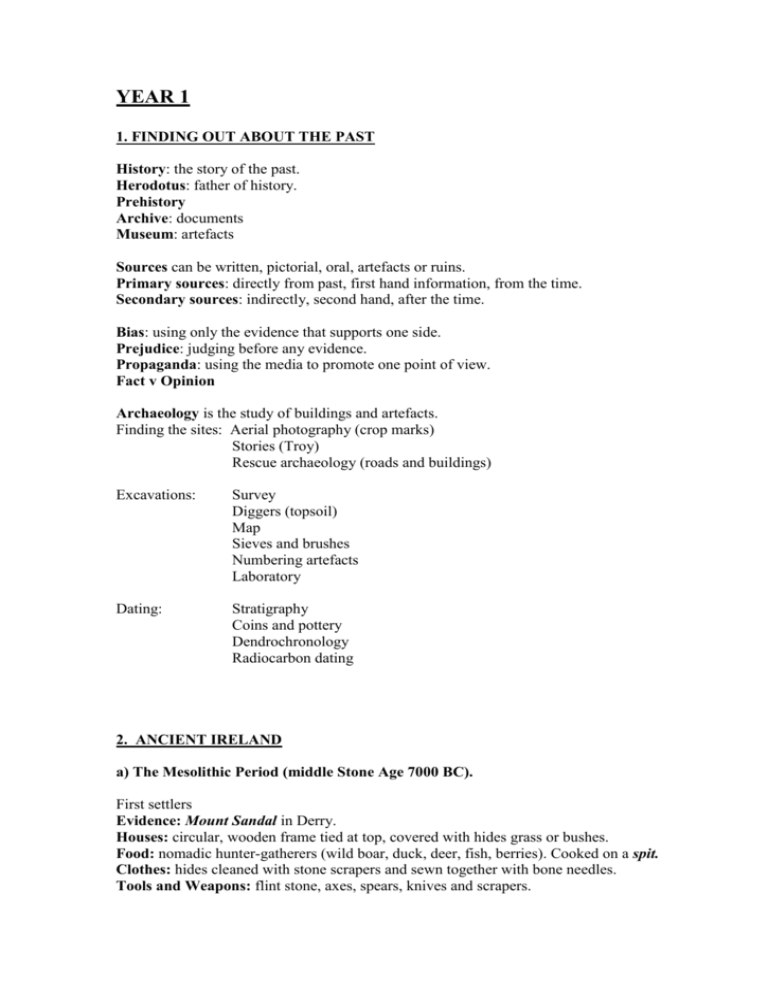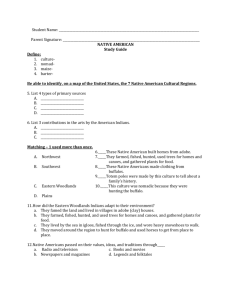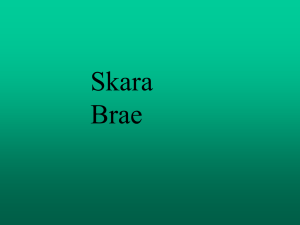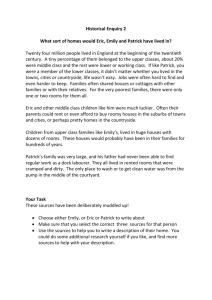YEAR 1 - St Kevins College
advertisement

YEAR 1 1. FINDING OUT ABOUT THE PAST History: the story of the past. Herodotus: father of history. Prehistory Archive: documents Museum: artefacts Sources can be written, pictorial, oral, artefacts or ruins. Primary sources: directly from past, first hand information, from the time. Secondary sources: indirectly, second hand, after the time. Bias: using only the evidence that supports one side. Prejudice: judging before any evidence. Propaganda: using the media to promote one point of view. Fact v Opinion Archaeology is the study of buildings and artefacts. Finding the sites: Aerial photography (crop marks) Stories (Troy) Rescue archaeology (roads and buildings) Excavations: Survey Diggers (topsoil) Map Sieves and brushes Numbering artefacts Laboratory Dating: Stratigraphy Coins and pottery Dendrochronology Radiocarbon dating 2. ANCIENT IRELAND a) The Mesolithic Period (middle Stone Age 7000 BC). First settlers Evidence: Mount Sandal in Derry. Houses: circular, wooden frame tied at top, covered with hides grass or bushes. Food: nomadic hunter-gatherers (wild boar, duck, deer, fish, berries). Cooked on a spit. Clothes: hides cleaned with stone scrapers and sewn together with bone needles. Tools and Weapons: flint stone, axes, spears, knives and scrapers. b) The Neolithic Period (new Stone Age 4000 BC). First farmers arrived by dugout canoe. Evidence: Lough Gur in Limerick, Ceide Fields in Mayo and the Boyne Valley. Houses: rectangular, posts, wattle and daub, thatched roof, hearth inside and hole for chimney in roof. Food: farming and hunting and gathering. Farm animals were cattle, pigs, sheep and goats. Mattock and wooden plough in light upland soil to grow wheat and barley. Grain ground on a saddle-stone. Food cooked on a spit. Clothes: same as Mesolithic. Tools and weapons: flint stone, axes, spears, knives and scrapers. Now they are polished. Pottery is used for storing food and in burials. Burial Customs and Religion. Megaliths. Usually cremated and ashes put in pots inside the following: Court Cairns (northern half, A shaped, court for ceremonies, all covered in stones). Portal Dolmens (covered in stones, how did they lift capstone). Passage Tombs (Newgrange, Knowth and Dowth). Cross shaped, 80 metres in diameter (Newgrange), corbelled roof, carved kerbstones, entrance stone, roof box. c) The Bronze Age (2000 BC). Copper Mount Gabriel in Cork. Tin Cornwall. How did they get copper from rock? Houses: circular, posts, wattle and daub, thatch, hearth inside and hole in roof. Ditch and fence around houses. Food: same as Neolithic but fulachta fiadh used as well as spits and copper cauldrons. Tools and weapons: bronze, sickles, spades axes, spears, swords. Arts and crafts: copper and gold jewellery. Lunulae and torcs (twisted gold), fasteners, collars, bracelets and necklaces. Burial customs and religion: wedge tombs, cist graves, stone circles (may be linked to sun’s movements), galláns (standing stones). Buried in crouched position with grave goods (afterlife). Some cremated, ashes in pots. d) The Iron Age and the Celts (by 300 BC iron had taken over) Evidence: Romans, Halstatt, La Tene, Christian writings and archaeological evidence. Houses: ring-forts (raths and cashels), Crannógs (well-off?). Hill-forts (Tara) and promontory forts (Dun Aengus). Ceremonial. Chevaux de frise Houses built in same way as Bronze Age. Souterrains (escape and cool food) Family: described below in order of importance. Rí or Taoiseach ruled a Tuath and were appointed by the Derbfine. Fosterage in use. The Nobles were made up of the warriors and the Aosdána. Aosdána were Brehons, Filí, Druids and craftsmen. Farmers Commoners or Slaves (captured from other tribes) Food: Mainly cattle but also sheep and pigs. Dairy products. Wheat (bread), oats (porridge) and barley (ale). Rotary quern. Spit and fulachta fiadh still used and also stone ovens. Feasting important. Poems, stories, music, ficheall (chess) baire (hurling). Hero’s portion. Clothes: wool spun and woven. Mantle. Tools and weapons: iron smelting. Bronze and gold still use for ornaments. Arts and crafts: Lá Tene (Switzerland), Ogham stones. Burial customs and Religion: Lug, Bridget. Cremated and ashes put in pits or put in cist graves with a mound of stones (cairn) on top. Grave-goods included. e) Early Christian Ireland. (Early 400s AD) First arrived in the south-east. Some may have been slaves. Palladius sent as bishop. Patrick best known. The story of Patrick. Most Celts were Christian by 600. Celtic life continued as before but druids lost power. Monasteries: Remote areas (Skellig Michael, Glendalough). Round towers (2 used). Beehive cells (clocháns). Scriptorium (Book of Kells, Cathach) manuscripts on parchment or vellum. Monks worked in fields. Attacks by other clans, other monasteries and Vikings. Arts and crafts: Metalwork. Filigree (Ardagh and Derrynaflan chalices, Tara brooch) High crosses (Muireadeach’s Cross in Monasterboice) Irish monks abroad: ‘Island of saints and scholars’ Columcille in Iona, Columbanus in Bobbio Italy. 3. ANCIENT ROME Controlled most of Europe and North Africa. Evidence: ruins, coins, Latin documents. Towns: grid pattern, Forum (marketplace), temples, amphitheatre (gladiators, Coliseum), aqueducts (water), roads (cobbled, Apian way), circus (chariot racing), sewerage system, town walls. Baths, public and private every day. Houses: patricians lived in houses, plebeians lived in apartments. Private house called a domus. Atrium (open courtyard in middle). Peristylium (walled garden). Tiled roofs. Mosaic floors. Villas in country. Apartments: called insulae. Poor tenants at top, better off in middle, shops at bottom. Family: father totally in charge. Strict discipline. Married young (12 and 14) Clothes: knee-length tunics. Toga for men, stola for women. Food: bread and porridge for poor. Rich ate a lot of meat, lying down. Vomitorium. Education: rich only. Secondary for boys only. Very strict. Stylus on wax tablets. Leisure and Entertainment: gladiators in amphitheatres (Coliseum) emperor’s thumb. Chariot racing in Circus Maximus. Plays in semi-circular theatres. Work: slaves did most farming and general labouring. Poor Romans were craftsmen and shopkeepers. Middle class was architects and doctors. Wealthy became generals or senators. The army: legions of 5000. Highly trained. Javelins, short sword, armour and shield. Strict discipline (decimation). Forts along border of empire (Hadrian’s wall). Giant catapults and cross-bows (ballistas). Architecture: see Renaissance. Lots of sculpture and frescoes. Religion and death: Many gods. Jupiter (father of all gods). Neptune (sea). Mars (war). Funeral processions followed by cremation and ashes put in urns and buried. Christians buried in catacombs. Reasons for fall of Rome: 1. Power struggles between those wanting to be emperor. 2. High cost of army. 3. Corruption. 4. Barbarian tribes (anyone outside empire) 4. MEDIEVAL TIMES (middle ages, feudal times, dark ages) a) General: Fall of ancient Rome to Renaissance. A time of war, little interest in education, plague and a reduction in population of Europe. Feudal system: Kings granted land, called a fief, to vassals in return for soldiers. Kings, barons, knights, bishops and abbots, freemen and serfs. Knights lived on Manors. They kept some for themselves (demesne) and rented out the rest to peasants. Norman invasion of Britain: William the Conqueror, Battle of Hastings 1066, Bayeux Tapestry. Norman invasion of Ireland: Rory O Connor V Dermot McMorrough king of Leinster. Asked Henry II for help. Strongbow (Richard de Clare) marries Aoife in Waterford (1169). Normans take Dublin from Vikings. b) Castle: Motte and Bailey castle: used early on or by poorer knights. Bailey was the courtyard. An example is Knockgraffon in Tipperary. Stone castle: strategic location, moat, battlements, drawbridge, portcullis, gatehouse, The Keep: great hall, solar, spiral staircase, arrow slits, dungeon, garderobes tapestries. Siege: undermining the wall, giant catapult, battering ram, hot oil, scaling-ladders Gunpowder meant the end. The lord: controlled territory, fought wars, administered justice, attended tournaments and hunted. The lady: ran the keep, came with a dowry, had an arranged marriage, looked after daughter’s education. Feasts in the great hall. Jesters, musicians. Knives and spoons only. Lots of meat. Drank wine, ale and mead. c) Knights: Page: 7 to 14. Learned manners and attended to lady. Squire: 14 to 21. Trained for fighting (sword, mace, lance, crossbow, longbow). Helped with lord’s armour. Learned code of chivalry. Knighthood: night in church. Dubbed. ‘Arise Sir…’ Tournaments and Jousts: mock battles. Coat of arms. d) The Manor: The Manor was the village and the land around it. Knight or lord: lived in manor-house (sometimes called a grange), and bailiff ran manor-farm. The demesne was kept for lord or knight. The life-style of the knight was similar to that of a lord, but was not as well off. The manor-house was made of wood and plaster. Peasants: lived in 2 rooms. Houses made of wattle and daub and thatch. Houses had 2 rooms, one for family and one for animals. Freemen paid money rent and could go when they wanted. Serfs could not (year and a day). All had to work for lord at certain times. All had to use the lord’s mill. All had to pay tithes. Open field system: 3 fields.1 fallow. Strips. Crop rotation. Common land. Animal parts not salted in autumn burned on ‘bonefires’ at Halloween. Food: porridge for breakfast. Bread and cheese for lunch. Pottage (thick vegetable soup). Peasants rarely had meat. Ale or beer. Clothes: wool spun and woven. Tower houses: replaced manor-house for protection. Built by Gaelic Irish as well as Anglo-Norman. Rectangular, spiral staircase, murder-hole, door high up, had bawns for peasants. e) Towns and cities Normans developed Viking towns and also built new ones at: river crossings, ports, route crossings and around castles. A town charter granted by the king gave the town the right to have a corporation, fairs and markets and courts. Towns had walls. Houses made of wood (curfew). Open sewers. Chamber pots onto narrow streets with the shout ‘Gardez-loo’. Market cross. Town crier. Merchants and Craftsmen: merchants well off, lived in stone houses. Craftsmen had workshops on ground floor with a sign outside (few could read). Guilds: controlled standards and prices, decided who became master craftsmen, looked after sick members and their families. Apprentice at 14. Lived with master. Could be punished. 7 years. Journeyman. Could work for anyone. Paid by the day. Had to make a masterpiece to become a master. Markets and Fairs: markets weekly at market cross. Fairs once or twice a year on the fair green (outside the walls). Lasted a week or more. Entertainment (bear and bull baiting, jugglers, musicians, fire-eaters) Crime and Punishment: no one on streets after curfew. Stocks or Pillory. Hands chopped off. Torture, hanging and beheading. f) Churches and monasteries Bishops (dioceses), parishes. Church very powerful. Power shown in architecture. Romanesque: rounded arches, square towers, thick walls and columns Gothic: pointed arches, slender columns, thin walls supported by buttresses, rose windows and lancet windows. Medieval Monasteries: different orders such as Benedictines and Cistercians. Rule of St. Benedict. Poverty, chastity and obedience. Lay brothers. Main buildings: cloisters, church, almonry, refectory, dormitory, infirmary, chapter house and scriptorium. Main Monks: Abbot, novice master, infirmarian, almoner, hospitallar (guests). Monasteries were very important to the community. Monk’s day: Up very early. Down to church to pray. Breakfast in refectory. Meeting in chapter house to get jobs for day, punish and read a chapter from the Rule of St. Benedict. More prayers. Work. Prayer. Dinner. Prayer. Work. Prayer. Supper. Prayer. Bed at eight. Begging monks or friars: Dominicans and Franciscans lived among people. Did not agree with the wealthy monasteries. Plague or Black Death: killed one quarter to one third of population. Flea on black rat. Towns hit hardest. 5. THE RENAISSANCE The Renaissance is the rebirth of learning. The learning of ancient Greece and Rome was rediscovered and new discoveries made. Humanism is showing great interest in human nature rather than religion. Writing in the vernacular became popular. Artists were craftsmen like other tradesmen. Why Italy? Wealth cities provided patrons of the arts. Fall of Constantinople. Competition between city-states. Ruins of Ancient Rome. Differences between Medieval and Renaissance art: Religion a theme but other themes important also. Movement and emotions became important. Realism. Perspective. Sfumato. Oils and canvas became popular but egg tempera and frescoes still used. Architecture moved from Gothic to Romanesque. Important people of the Renaissance: a) Patrons of the Arts: Lorenzo de Medici: family ruled Florence. ‘The Magnificent’ collected ancient Greek and Roman manuscripts. Michelangelo was a pupil at the Platonic Academy. Spent a fortune on art. The popes Leo X (Lorenzo’s son) and Julius II (Sistine Chapel) b) Johannes Gutenberg. He was a goldsmith from Mainz in Germany. Invented the movable metal type printing press. His bible is very valuable. Invention of printing press important because: 1. Books more plentiful and cheaper. 2. Literacy and education spread. 3. Spread ideas of Renaissance and Reformation. c) Leonardo da Vinci. Renaissance man (wide range) Apprenticed to Verrochio. He was the first to use sfumato. Painted the Last Supper (falling apart) and the Mona Lisa (Louvre). Dissected more than 30 bodies. Used mirror writing. Designed planes, parachutes, cannon and tanks. Died in France. d) Michelangelo. Attended Platonic Academy. Loved sculpture. White marble. The Pieta (optical illusion). David was the biggest statue of the time and showed mastery of anatomy. Julius II ordered him to paint the ceiling of the Sistine Chapel. It took 4 years. He designed the dome of St. Peter’s. He was a poet also. e) Durer. From Nuremberg. Trained as an engraver. Famous for self-portraits and pictures of plants(Large Clod) and animals (Young Hare). His engravings could be printed. Very scientific approach. f) Galileo. The Father of Modern Science. Invented the pendulum clock and a powerful telescope. Discovered that all solid objects fall at the same speed. He proved Copernicus was right when he said the Earth moved around the sun, but had to say he was wrong in front of the Inquisition. g) Shakespeare. Stratford on Avon. Married Anne Hathaway. Moved to London without the family. Worked in the Globe Theatre (open air, no women actors). Wrote 35 plays (Hamlet, Romeo and Juliet) and many sonnets. His plays are comedies, tragedies and histories.






